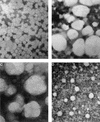Characterization of low- and very-low-density hepatitis C virus RNA-containing particles
- PMID: 12072493
- PMCID: PMC136313
- DOI: 10.1128/jvi.76.14.6919-6928.2002
Characterization of low- and very-low-density hepatitis C virus RNA-containing particles
Abstract
The presence of hepatitis C virus (HCV) RNA-containing particles in the low-density fractions of plasma has been associated with high infectivity. However, the nature of circulating HCV particles and their association with immunoglobulins or lipoproteins as well as the characterization of cell entry have all been subject to conflicting reports. For a better analysis of HCV RNA-containing particles, we quantified HCV RNA in the low-density fractions of plasma corresponding to the very-low-density lipoprotein (VLDL), intermediate-density lipoprotein, and low-density lipoprotein (LDL) fractions from untreated chronically HCV-infected patients. HCV RNA was always found in at least one of these fractions and represented 8 to 95% of the total plasma HCV RNA. Surprisingly, immunoglobulins G and M were also found in the low-density fractions and could be used to purify the HCV RNA-containing particles (lipo-viro-particles [LVP]). Purified LVP were rich in triglycerides; contained at least apolipoprotein B, HCV RNA, and core protein; and appeared as large spherical particles with a diameter of more than 100 nm and with internal structures. Delipidation of these particles resulted in capsid-like structures recognized by anti-HCV core protein antibody. Purified LVP efficiently bind and enter hepatocyte cell lines, while serum or whole-density fractions do not. Binding of these particles was competed out by VLDL and LDL from noninfected donors and was blocked by anti-apolipoprotein B and E antibodies, whereas upregulation of the LDL receptor increased their internalization. These results suggest that the infectivity of LVP is mediated by endogenous proteins rather than by viral components providing a mechanism of escape from the humoral immune response.
Figures







References
-
- Agnello, V. 1997. Hepatitis C virus infection and type II cryoglobulinemia: an immunological perspective. Hepatology 26:1375-1379. - PubMed
-
- Barba, G., F. Harper, T. Harada, M. Kohara, S. Goulinet, Y. Matsuura, G. Eder, Z. Schaff, M. J. Chapman, T. Miyamura, and C. Brechot. 1997. Hepatitis C virus core protein shows a cytoplasmic localization and associates to cellular lipid storage droplets. Proc. Natl. Acad. Sci. USA 94:1200-1205. - PMC - PubMed
-
- Bradley, D., K. McCaustland, K. Krawczynski, J. Spelbring, C. Humphrey, and E. H. Cook. 1991. Hepatitis C virus: buoyant density of the factor VIII-derived isolate in sucrose. J. Med. Virol. 34:206-208. - PubMed
Publication types
MeSH terms
Substances
LinkOut - more resources
Full Text Sources
Other Literature Sources
Research Materials

